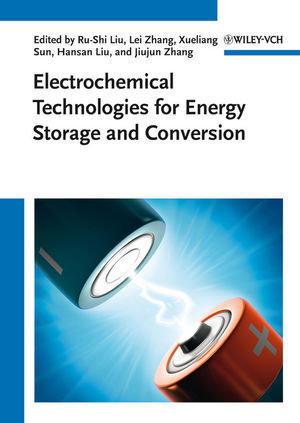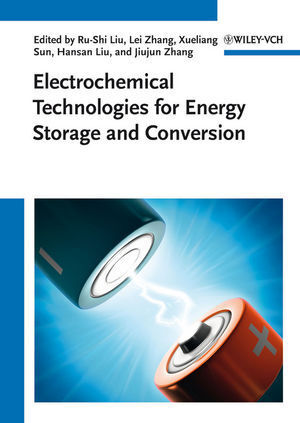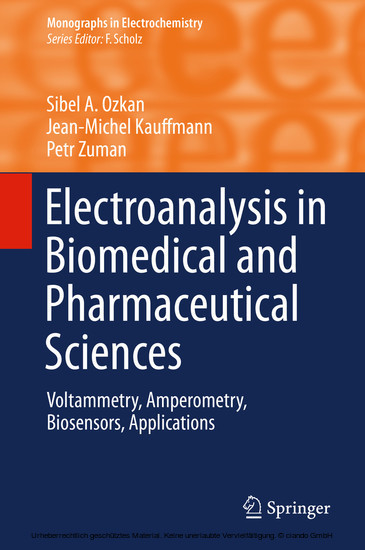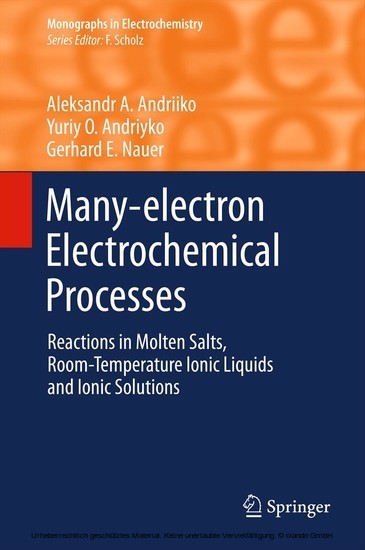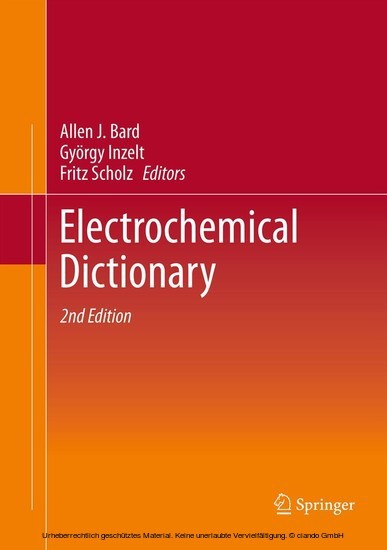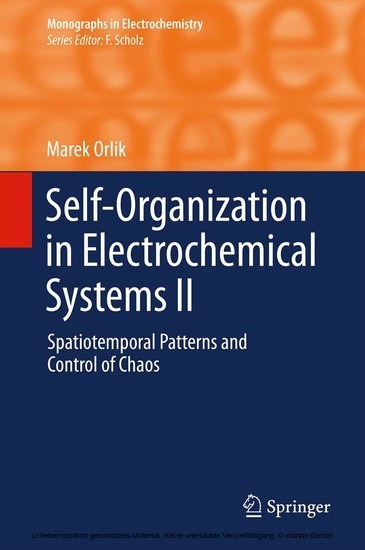Modeling Electrochemical Energy Storage at the Atomic Scale
Modeling Electrochemical Energy Storage at the Atomic Scale
The series Topics in Current Chemistry Collections presents critical reviews from the journal Topics in Current Chemistry organized in topical volumes. The scope of coverage is all areas of chemical science including the interfaces with related disciplines such as biology, medicine and materials science. The goal of each thematic volume is to give the non-specialist reader, whether in academia or industry, a comprehensive insight into an area where new research is emerging which is of interest to a larger scientific audience.
Each review within the volume critically surveys one aspect of that topic and places it within the context of the volume as a whole. The most significant developments of the last 5 to 10 years are presented using selected examples to illustrate the principles discussed. The coverage is not intended to be an exhaustive summary of the field or include large quantities of data, but should rather be conceptual, concentrating on the methodological thinking that will allow the non-specialist reader to understand the information presented. Contributions also offer an outlook on potential future developments in the field.
The chapters 'Assessment of Simple Models for Molecular Simulation of Ethylene Carbonate and Propylene Carbonate as Solvents for Electrolyte Solutions' and 'Elucidating Solvation Structures for Rational Design of Multivalent Electrolytes-A Review' are available open access under a CC BY 4.0 License via link.springer.com.
Each review within the volume critically surveys one aspect of that topic and places it within the context of the volume as a whole. The most significant developments of the last 5 to 10 years are presented using selected examples to illustrate the principles discussed. The coverage is not intended to be an exhaustive summary of the field or include large quantities of data, but should rather be conceptual, concentrating on the methodological thinking that will allow the non-specialist reader to understand the information presented. Contributions also offer an outlook on potential future developments in the field.
The chapters 'Assessment of Simple Models for Molecular Simulation of Ethylene Carbonate and Propylene Carbonate as Solvents for Electrolyte Solutions' and 'Elucidating Solvation Structures for Rational Design of Multivalent Electrolytes-A Review' are available open access under a CC BY 4.0 License via link.springer.com.
1;Contents;6 2;Preface;7 3;Fundamental Challenges for Modeling Electrochemical Energy Storage Systems at the Atomic Scale;9 3.1;Abstract;9 3.2;1 Introduction;9 3.3;2 Basic Principles of Battery Operation;11 3.4;3 Computational Methods;13 3.5;4 Descriptors;14 3.6;5 Dendrite Growth in Batteries;14 3.7;6 Structure of Interfaces in Electrochemical Storage Devices;17 3.7.1;6.1 Grand-Canonical Approach to Consider the Presence of Electrolytes at Interfaces;17 3.7.2;6.2 Description of Electrolytes in Implicit Solvent Models;19 3.7.3;6.3 Explicit Atomistic Modeling of ElectrodeElectrolyte Interfaces;22 3.8;7 Atomistic Modeling of Bulk Electrode Properties;24 3.9;8 Conclusions;26 3.10;Acknowledgements;26 3.11;References;26 4;Interfaces and Materials in Lithium Ion Batteries: Challenges for Theoretical Electrochemistry;31 4.1;Abstract;31 4.2;1 Terminology;32 4.3;2 Introduction to Electrochemical Energy Storage Devices;33 4.4;3 Introduction to Lithium Ion Cell Chemistry;36 4.5;4 Anode Materials for LIBs;38 4.5.1;4.1 Lithium Metal, the Ancestor Anode of LIB Electrodes;38 4.5.2;4.2 Classification of Anode Materials;38 4.5.3;4.3 Graphitic and Non-Graphitic Carbon Anodes;39 4.5.4;4.4 Lithium Titanate;41 4.6;5 Cathode Materials for Lithium Ion Batteries;41 4.7;6 Electrolytes for LIBs;46 4.8;7 Conclusion;53 4.9;References;53 5;Assessment of Simple Models for Molecular Simulation of Ethylene Carbonate and Propylene Carbonate as Solvents for Electrolyte Solutions;60 5.1;Abstract;60 5.2;1 Introduction;61 5.2.1;1.1 Methods and Force Fields;63 5.2.2;1.2 Plan of this Report;64 5.3;2 Ethylene Carbonate and Propylene Carbonate Liquids;64 5.3.1;2.1 Molecular Mobilities;66 5.3.2;2.2 Dielectric Constants and Relaxation Times;69 5.3.3;2.3 Non-linear Polarization Response;70 5.3.4;2.4 Electrochemical Double-Layer Capacitor Based on CNT Forests;70 5.4;3 Empirically Scaled Partial Charges for Li...Carbonate Interactions;73 5.4.1;3.1 Free Energy Results and Quasi-Chemical Theory (QCT);73 5.4.2;3.2 Radial Distribution Function;75 5.4.3;3.3 Ion Mobilities;75 5.5;4 Model solid electrolyte interphase layer;77 5.6;5 Conclusions;78 5.7;Acknowledgements;79 5.8;References;79 6;Elucidating Solvation Structures for Rational Design of Multivalent Electrolytes-A Review;85 6.1;Abstract;85 6.2;1 Introduction;86 6.3;2 Magnesium Electrolytes;89 6.3.1;2.1 Simple Inorganic Mg Salts;90 6.3.2;2.2 Organometallic Compounds (Complex Salts);101 6.3.3;2.3 Aqueous Mg Electrolytes;108 6.3.4;2.4 Mg Polymer Electrolytes;109 6.4;3 Zinc Electrolytes;114 6.5;4 Calcium Electrolytes;119 6.6;5 Rational Design of Electrolytes;120 6.7;6 Conclusions;121 6.8;Acknowledgements;123 6.9;References;123 7;Towards Synergistic Electrode-Electrolyte Design Principles for Nonaqueous Li-O batteries;131 7.1;Abstract;131 7.2;1 Introduction;132 7.3;2 Electrolyte Design;133 7.3.1;2.1 Electrochemical Stability;133 7.3.2;2.2 Chemical Stability;135 7.3.3;2.3 Ionic Solubility;137 7.3.4;2.4 Stringent Limitations and Fundamental Trade-Offs;138 7.4;3 Cathode Electrocatalyst Design;139 7.4.1;3.1 Discharge Pathways;139 7.4.2;3.2 Discharge Product Nucleation Thermodynamics;141 7.4.3;3.3 Lithium Peroxide Nucleation;142 7.4.4;3.4 Lithium Oxide Nucleation and Trends in Discharge-Product Selectivity;142 7.4.5;3.5 Cathode Stability;143 7.5;4 Conclusions;147 7.6;Acknowledgements;147 7.7;References;147
Korth, Martin
| ISBN | 9783030005931 |
|---|---|
| Artikelnummer | 9783030005931 |
| Medientyp | E-Book - PDF |
| Copyrightjahr | 2018 |
| Verlag | Springer-Verlag |
| Umfang | 151 Seiten |
| Sprache | Englisch |
| Kopierschutz | Digitales Wasserzeichen |



